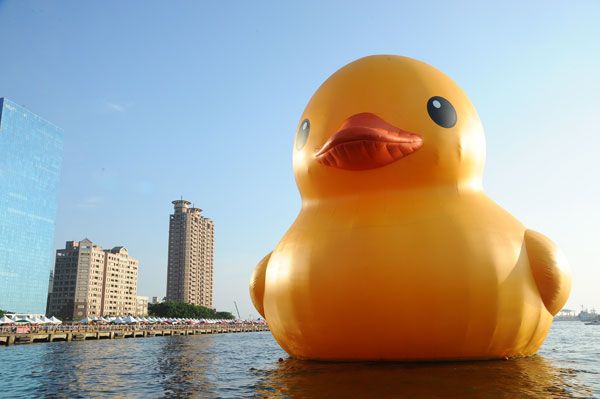
Florentijn Hofman’s rubber duck is at it again. This time, the giant inflatable art piece is in Seoul, sitting in the middle of a controversial $3.3 billion development project. According to the artist, his rubber duck is an artistic “catalyst” and won’t be hijacked for PR stunts. But is that really so?
The Lotte Group is constructing what it hopes will be Asia’s largest shopping mall in a landmark 123-story-tall structure, dubbed the Lotte World Tower. It is scheduled for completion by the end of 2016. But the project hit a snag when sinkholes began to appear in the area and the water level of nearby Seokchon Lake began to decline, sparking intense public scrutiny over the safety of the development.
So far there is no confirmed link between the environmental problems and the construction site. The project won approval from authorities to open its first phase on October 14 and the rubber duck floated on the troubled Seokchon Lake to mark the occasion.
Dutch artist Hofman insists that the environmental issues were all “purely coincidental” and that Lotte had contacted him as early as last year to bring the sculpture to Seoul.
“Each project rubber duck in the world needs a sponsor, and in this case it’s Lotte. And that’s it,” the Dutch artist told reporters in Korea on Tuesday, according to Yonhap News.
The blow-up bird has toured the world, becoming a smash-hit in each city it visits, including Hong Kong, Sydney, and Sao Paolo. So far, more than 700,000 people have visited the duck’s month-long outing in Seoul, according to the Songpa Ward office that co-hosts the project. Five thousand miniature versions of the duck, each signed by the artist, have mostly sold out.
Florentijn Hoffman, Rubber Duck, outside the Chrysler Museum of Art, Norfolk, Virginia. Photo: Sarah Cascone.
Hofman said he had expected the rubber duck to be provocative: “I always say that the rubber duck is a catalyst. It simply shows what’s here. If there are problems in the vicinity because of the tower, it simply shows it and starts a conversation.”
He also told Korean media that he hopes his public artwork can help to relieve the mass grief following April’s Sewol ferry tragedy in which more than 300 people died, most of them high school students heading for a school field trip.
“I feel very connected because it was on my birthday. It’s an honor to bring this project here, and if it can help relieve some grief and sadness, I’ll be very happy,” says Hofman.
The artist explained that he chose to exhibit the rubber duck on the controversial Seokchon Lake because it offered a close-up, 360-degree view of the sculpture.
When asked further about the problem of sponsorship for his massive installations, Hofman said: “If you look at a museum, it’s also paid by companies. A museum also brings in people, they want money to show art … I think a commissioner who brings a rubber duck has benefits; I’m not blind. But they respect the art to stand alone.”